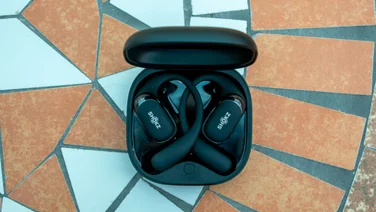Headphones & Audio

CES 2026: Cambridge Audio launched three new speakers in Vegas, and the largest of them rocked The Cosmopolitan
Having had my socks blown off by the Cambridge Audio L/R X, I’m excited to test their smaller sibling, the L/R S, in the next couple of months
-
 CES 2026: Anker takes on the AirPods 4 with the Soundcore AeroFit Pro 2 Three new Anker Soundcore products caught my eye at CES, including the brand’s answer to Apple’s AirPods 4 ANC
CES 2026: Anker takes on the AirPods 4 with the Soundcore AeroFit Pro 2 Three new Anker Soundcore products caught my eye at CES, including the brand’s answer to Apple’s AirPods 4 ANC -
recommended
 Shokz OpenFit Pro: A watershed moment for Shokz The OpenFit Pro deliver the best open-ear sound we’ve heard to date, and their new noise reduction tech works well, but they aren’t quite the use-anywhere earbuds I’d hoped for£219
Shokz OpenFit Pro: A watershed moment for Shokz The OpenFit Pro deliver the best open-ear sound we’ve heard to date, and their new noise reduction tech works well, but they aren’t quite the use-anywhere earbuds I’d hoped for£219 -
 Amazon Echo Show 8: On the ball Freshly redesigned for Alexa+ the Echo Show 8 is better, but much the same£180
Amazon Echo Show 8: On the ball Freshly redesigned for Alexa+ the Echo Show 8 is better, but much the same£180 -
 Huawei FreeClip 2 announced, alongside MatePad 11.5 S and Mate X7 foldable Huawei’s jewellery-style open-air headphones get a big overhaul, there’s a new Mate X7 smartphone, an unusual-looking new Wi-Fi system and an updated MatePad 11.5 S tablet
Huawei FreeClip 2 announced, alongside MatePad 11.5 S and Mate X7 foldable Huawei’s jewellery-style open-air headphones get a big overhaul, there’s a new Mate X7 smartphone, an unusual-looking new Wi-Fi system and an updated MatePad 11.5 S tablet -
 The best headphones to buy in 2025 Take your audio enjoyment to new heights with our pick of the best headphones to suit all budgets and style preferences
The best headphones to buy in 2025 Take your audio enjoyment to new heights with our pick of the best headphones to suit all budgets and style preferences -
 Philips H8000E review: H8 is a strong word Philips has squeezed a welcome number of advanced features into the H8000E and slapped a very attractive price on them, but they have a few weak spots£130
Philips H8000E review: H8 is a strong word Philips has squeezed a welcome number of advanced features into the H8000E and slapped a very attractive price on them, but they have a few weak spots£130 -
 Why the Sony WH-1000XM5 and Sony ULT Wear are the perfect alternatives to the WH-1000XM4 this December Struggling to find the Sony WH-1000XM4 in stock? Fear not, Sony has a couple of alternatives that make cracking Christmas gifts
Why the Sony WH-1000XM5 and Sony ULT Wear are the perfect alternatives to the WH-1000XM4 this December Struggling to find the Sony WH-1000XM4 in stock? Fear not, Sony has a couple of alternatives that make cracking Christmas gifts -
approved deal
 The top tested wireless earbuds for all budgets Upgrade your listening experience with a pair of the best wireless earbuds, as tested and recommended by our team of audio experts
The top tested wireless earbuds for all budgets Upgrade your listening experience with a pair of the best wireless earbuds, as tested and recommended by our team of audio experts -
best buy
 Shokz OpenFit 2 and 2 Plus review: High voltage With better audio, longer battery life and a slightly lower price tag, the Shokz OpenFit 2 are the best air-conduction headphones yet£169
Shokz OpenFit 2 and 2 Plus review: High voltage With better audio, longer battery life and a slightly lower price tag, the Shokz OpenFit 2 are the best air-conduction headphones yet£169 -
 The best over-ear headphones to buy Want the best over-ear headphones - wired or wireless, noise-cancelling or not? Our experts have tested them all so you don’t have to
The best over-ear headphones to buy Want the best over-ear headphones - wired or wireless, noise-cancelling or not? Our experts have tested them all so you don’t have to -
 Our favourite budget ANC headphones are cheaper than ever for Black Friday The Anker Soundcore Life Q30 aren’t sleek or sexy but they deliver where it counts and for a frankly paltry price this Black Friday
Our favourite budget ANC headphones are cheaper than ever for Black Friday The Anker Soundcore Life Q30 aren’t sleek or sexy but they deliver where it counts and for a frankly paltry price this Black Friday -
 The Sony WH-1000XM5 are £200 in a Black Friday deal not to be missed The Sony WH-1000XM5 are among our favourite ever over-ear headphones and are cheaper than ever thanks to this Black Friday deal
The Sony WH-1000XM5 are £200 in a Black Friday deal not to be missed The Sony WH-1000XM5 are among our favourite ever over-ear headphones and are cheaper than ever thanks to this Black Friday deal
